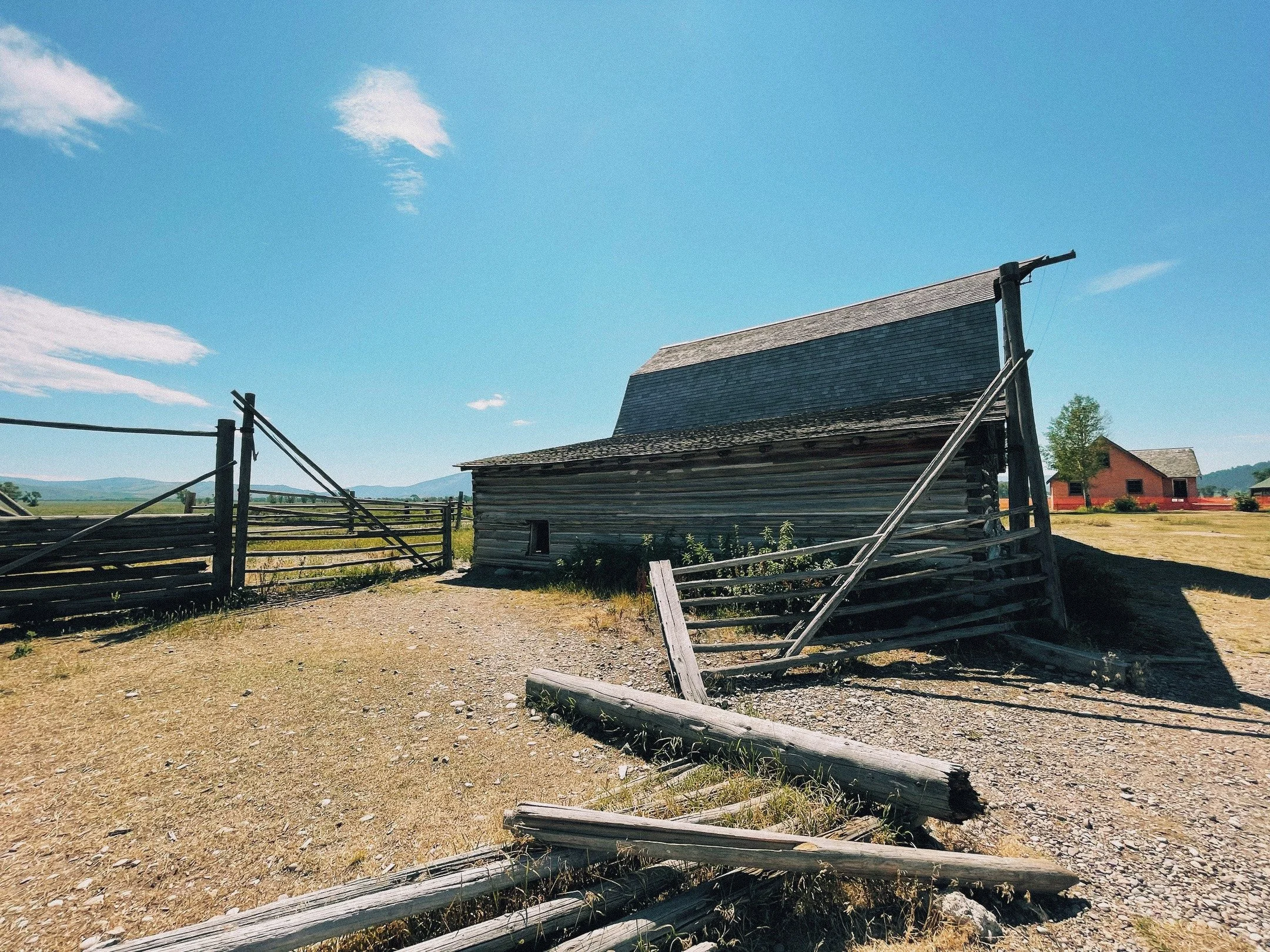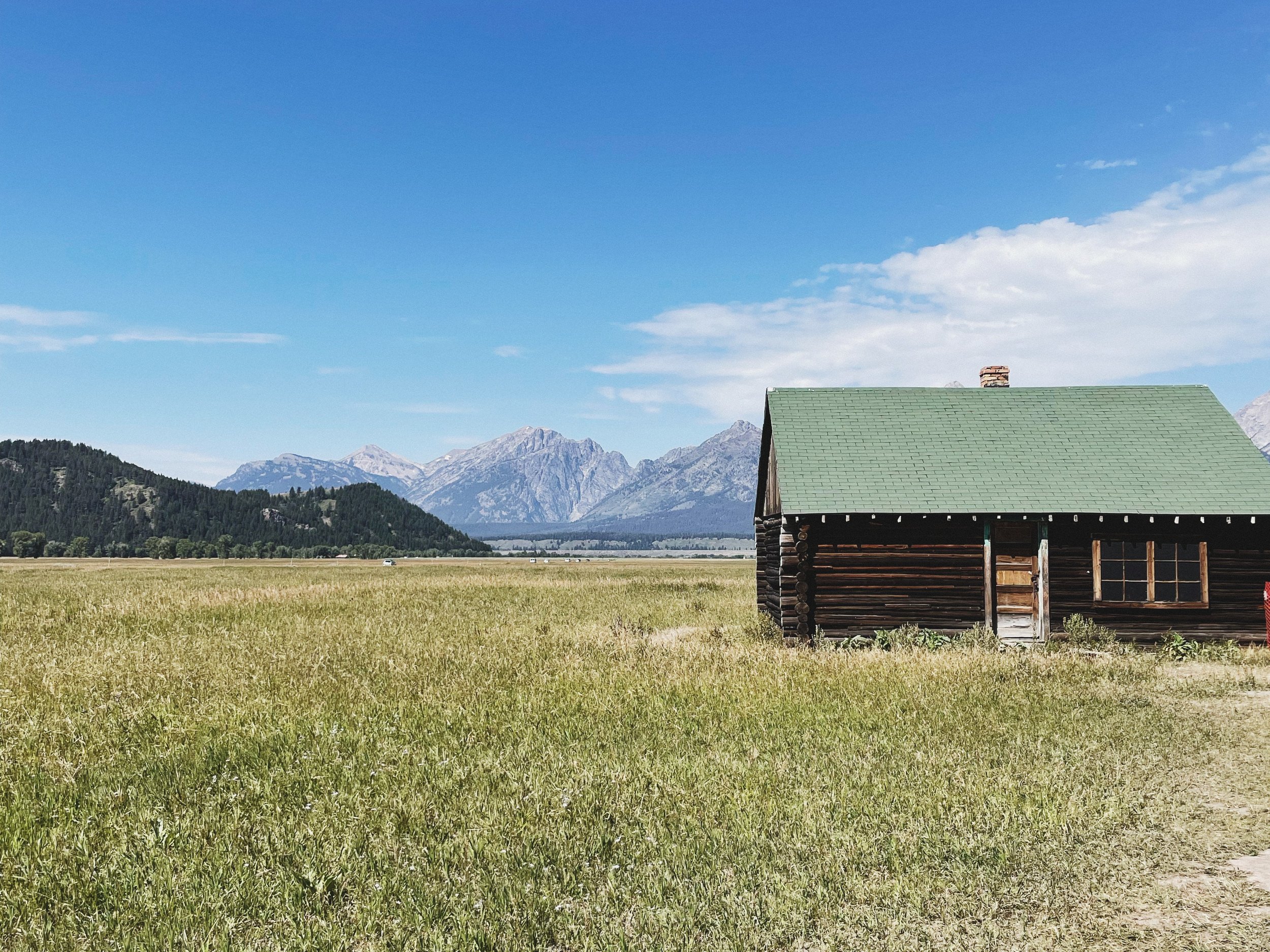Discover Mormon Row: A Journey Through the History of the American West.
Historic John Moulton Barn with the Teton Range in the background in Grand Teton National Park.
Explore the Historic Mormon Row in Grand Teton National Park.
Nestled against the stunning backdrop of the Teton Range in Grand Teton National Park, Mormon Row stands as an intriguing historical district, preserving the remnants of early homesteads and iconic barns that speak to the resilience of the region's pioneers. Set amidst the vast Wyoming landscape, these weathered structures evoke a sense of timelessness, inviting visitors to wander through a portal to the past. With its rustic charm and panoramic views, this historic enclave serves as a tangible link to the challenges and triumphs of the settlers who, inspired by dreams of a better life, established their homes against the rugged beauty of the American West. Exploring Mormon Row offers a glimpse into the pioneer spirit, where determination met the untamed wilderness, leaving an indelible mark on the tapestry of the Grand Teton experience.
Grand Teton National Park, established in 1929, is renowned for its breathtaking landscapes, abundant wildlife, and outdoor recreational opportunities. Among its many treasures, Mormon Row stands out as a testament to the human spirit and the quest for a better life in the American West.
The History of Mormon Row: Pioneers in the American West.
Blacksmith Shed: view of the southeast corner - T. A. Moulton Ranch, Mormon Row Road Library of Congress Prints and Photographs
Mormon Row is a historic district in Grand Teton National Park, Wyoming, with a rich history rooted in the early settlement of the American West. In the late 19th and early 20th centuries, a group of Mormon homesteaders, led by Thomas Alma Moulton, settled in the area now known as Mormon Row. The settlers, mainly from the Church of Jesus Christ of Latter-day Saints (LDS), sought to establish a self-sufficient community, cultivating the land and building homes and barns to support their families.
The daily lives of these settlers were marked by hard work and a strong sense of community. They built irrigation systems to water their crops, constructed homes and barns using local materials, and relied on each other for support and cooperation. The Moulton and Shane homesteads on Mormon Row are particularly notable for their iconic barns, which have become enduring symbols of the region. The structures were constructed using local materials, showcasing the resourcefulness and practicality of the early settlers. With their distinctive Teton Range backdrop, the barns have become iconic subjects for photographers, capturing the essence of the American frontier.
Over time, changing economic conditions and the challenges of farming in the harsh environment led many of the Mormon settlers to leave the area. However, the legacy of their efforts is preserved in the historic district of Mormon Row, offering visitors a glimpse into the challenges and aspirations of those who carved a living from the land in the shadow of the majestic Tetons.
Historic Thomas Alma Moulton Barn with the majestic Teton Range in the background.
Why Visit Mormon Row? Top Attractions and Highlights.
Walking around a place that was a part of the early settlers' culture is quite an experience. Not to mention, the photography options here are amazing. Some of the most famous photos of Grand Teton are of the Moulton Barn with the Teton Range as the backdrop. Visiting Mormon Row offers a unique opportunity to step back in time and experience the pioneer lifestyle amidst one of the most picturesque landscapes in America. Here are the top attractions and highlights that make Mormon Row a must-visit destination:
Map of Mormon Row
1. Moulton Barns: Icons of the American West
The most famous structures on Mormon Row are the Moulton Barns. The Thomas Alma Moulton Barn and the John Moulton Barn are iconic and have become symbols of the American West. Their weathered exteriors against the Teton Range make them popular subjects for photographers. The barns are often called the most photographed in America, drawing photographers worldwide to capture their rustic beauty.
2. Shane Cabin: A Glimpse into Pioneer Life
Historic Shane Cabin with log construction and rustic surroundings in Grand Teton National Park.
Another historic structure on Mormon Row is the Shane Cabin, a small log cabin representing the modest dwellings of the early settlers. It provides insight into the pioneers' lifestyle and living conditions. The cabin's simple construction and isolated location offer a stark contrast to the grand landscapes surrounding it, highlighting the settlers' resilience and adaptability.
3. The Pink House: A Unique Homestead
John Moulton's Pink House with rustic surroundings in Grand Teton National Park.
The Pink House on the John Moulton farm stands out with its distinctive color and charming appearance. This unique structure adds a splash of color to the rustic landscape and offers another fascinating glimpse into the lives of the early settlers. It provides a picturesque setting for photographs and a tangible connection to the region's history.
4. Breathtaking Grand Teton Views
One of the highlights of Mormon Row is the unobstructed view of the Grand Teton mountain range. The Teton peaks provide a breathtaking backdrop to the historic homesteads, creating a picturesque and photogenic scene. Visitors often find themselves in awe of the sheer beauty of the landscape, where the rugged mountains meet the expansive plains.
5. Scenic Wyoming Landscape
Wooden fence with historic barns and open range in the background at Mormon Row, Grand Teton National Park.
The open landscape surrounding Mormon Row allows visitors to appreciate the vastness of the Wyoming wilderness. The expansive views of the plains and mountains contribute to the sense of isolation and natural beauty. Walking through the area, one can almost feel the past settlers' presence and the Wild West's untamed spirit.
5. Rich Historical Story
While exploring Mormon Row, visitors can learn about the history of the Mormon settlers who established these homesteads. Interpretive signs provide information about the challenges faced by the pioneers and the agricultural practices of the time. These stories bring to life the struggles and triumphs of the early settlers, making the visit both educational and inspiring.
Mormon Row is stepping back into the Wild West.
This place is something to see. It is an actual live Western movie set, but not a movie, as it was legit. This stop won’t take long, but I promise you it will be worth it, if anything, for the photography you will get. Oh. and let’s not forget all the prairie dogs you will see. They are so cute.
Visitor Tips and Practical Information.
Best Times to Visit: The best times to visit Mormon Row are spring and fall when the weather is mild and the landscape is particularly stunning. Early morning and late afternoon provide the best lighting for photography, and visitors will likely encounter fewer crowds.
How to Get There: Mormon Row is located within Grand Teton National Park, accessible via Antelope Flats Road. The area is well-signposted, and parking is available near the historic district. Visitors should be prepared for a short walk from the parking area to the homesteads.
Tips for Visiting:
Bring a Camera: Ensure you have plenty of memory and battery life to capture the stunning scenery.
Wear Comfortable Shoes: Expect some walking, so comfortable footwear is essential.
Dress Appropriately: Weather in Wyoming can be unpredictable; dress in layers and bring a hat and sunscreen.
Respect the Site: Preserve the historic structures and natural environment by following posted guidelines and staying on designated paths.
Read Interpretive Signs: Read the signs that provide valuable historical information about the area.
Look out for Wildlife: Look for prairie dogs and other wildlife that add to the area's charm.
Plan Your Visit: Before your trip, check the Grand Teton National Park website for updates on accessibility and visitor information.
Step Back into the Wild West at Mormon Row.
Visiting Mormon Row is like stepping back into the Wild West. This historic district offers a tangible connection to the past, allowing visitors to experience the pioneer spirit that defined the American West. The iconic barns, historic cabins, and breathtaking scenery make it a must-visit destination for anyone traveling to Grand Teton National Park. Plus, don't forget to look out for the adorable prairie dogs that inhabit the area—they add a charming touch to this historical site.
Mormon Row is more than just a collection of old buildings; it is a window into a bygone era where history comes alive. Whether you're a history enthusiast, a photography lover, or someone seeking a peaceful nature retreat, Mormon Row offers something for everyone.
If you enjoyed this post, please share it with fellow history buffs and photography enthusiasts. Have you visited Mormon Row? Leave a comment below with your favorite memories and photos.







